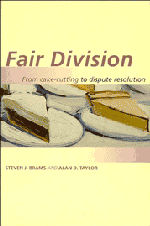Book contents
- Frontmatter
- Contents
- List of figures
- List of tables
- Acknowledgments
- Introduction
- 1 Proportionality for n = 2
- 2 Proportionality for n > 2: the divisible case
- 3 Proportionality for n > 2: the indivisible case
- 4 Envy-freeness and equitability for n = 2
- 5 Applications of the point-allocation procedures
- 6 Envy-free procedures for n = 3 and n = 4
- 7 Envy-free procedures for arbitrary n
- 8 Divide-the-dollar
- 9 Fair division by auctions
- 10 Fair division by elections
- 11 Conclusions
- Glossary
- Bibliography
- Index
3 - Proportionality for n > 2: the indivisible case
Published online by Cambridge University Press: 05 July 2011
- Frontmatter
- Contents
- List of figures
- List of tables
- Acknowledgments
- Introduction
- 1 Proportionality for n = 2
- 2 Proportionality for n > 2: the divisible case
- 3 Proportionality for n > 2: the indivisible case
- 4 Envy-freeness and equitability for n = 2
- 5 Applications of the point-allocation procedures
- 6 Envy-free procedures for n = 3 and n = 4
- 7 Envy-free procedures for arbitrary n
- 8 Divide-the-dollar
- 9 Fair division by auctions
- 10 Fair division by elections
- 11 Conclusions
- Glossary
- Bibliography
- Index
Summary
Introduction
The proportional procedures described in chapter 2 are not generally applicable to real-world situations involving indivisible goods, whose value is destroyed if they are divided. They were, in fact, designed for the case where the good being divided, such as cake or land, is divisible – that is, a cut can be made at any point.
In this chapter, by contrast, we assume that there are k different indivisible goods, which cannot be partially allocated. The fair division problem is to assign each such good to one and only one player so that each player thinks he or she is getting at least 1/n of the total.
We focus on two procedures for producing a proportional division of indivisible goods. The first is the “procedure of sealed bids” proposed by Knaster some fifty years ago (Steinhaus, 1948). This procedure seems quite practicable if the players all have an adequate reserve of money. The second procedure is the “method of markers” developed by William F. Lucas about twenty years ago (Lucas, 1994), which builds on ideas behind the lastdiminisher procedure and applies them to indivisible goods. These procedures are discussed in sections 3.2 and 3.3.
In section 3.4, we illustrate how these procedures might also be used to allocate goods when players have different entitlements, as in the case of estate division.
- Type
- Chapter
- Information
- Fair DivisionFrom Cake-Cutting to Dispute Resolution, pp. 51 - 64Publisher: Cambridge University PressPrint publication year: 1996



